Training your pet is essential for building a strong bond and ensuring good behavior. Whether you have a dog, cat, or another type of pet, knowing how to train a pet effectively can lead to a happier life for both you and your furry friend. In this guide, we’ll explore practical steps and tips for training your pet successfully.
How to Train Your Pet Dog
Training your pet dog involves teaching them commands and behaviors through consistent practice and positive reinforcement. Understanding how to train a pet is key to establishing good manners and ensuring your dog thrives in their environment. This process not only strengthens the bond between you and your creature but also makes both of you happier. By mastering how to train a pet effectively, you can enjoy the benefits of a well-behaved dog and a more fulfilling experience as a creature owner.
What Are the 5 Steps to Train a Dog: A Complete Guide on How to Train a Pet
The five steps mentioned above are fundamental for effective training. Understanding these steps will help you establish a solid foundation for your dog’s education. Combining these training techniques with a reliable containment system can enhance your Creature’s learning experience. Learn more about our pet containment solutions.
1. Establish Clear Commands
- Use simple, consistent commands such as “sit,” “stay,” “come,” and “down.”
- Ensure everyone in the household uses the same commands to avoid confusion for the dog.
2. Positive Reinforcement
- Reward your dog for good behavior with treats, praise, or playtime.
- This encourages them to repeat the desired behavior. Timing is crucial; rewards should be given immediately after the desired action.
3. Short Training Sessions
- Keep training sessions brief (5-10 minutes) to maintain your dog’s attention and enthusiasm.
- Frequent short sessions are more effective than longer, infrequent ones.
4. Regular Practice
- Consistency is key; practice commands in various environments and situations to help your dog generalize their training.
- Gradually increase distractions as your dog becomes more proficient in their commands.
5. Be Patient and Consistent
- Every dog learns at their own pace, so patience is essential.
- Stay consistent with commands and rewards, and avoid punishment, which can lead to fear and anxiety.
By following these steps, you can create a positive training experience that strengthens the bond between you and your dog while ensuring they learn essential behaviors.

What Is the Easiest Pet to Train?
While dogs are often considered the easiest companions to train due to their social nature, other companions like rabbits and some birds can also learn commands and tricks with proper techniques. However, understanding how to train a pet involves recognizing that each companion has unique needs when it comes to containment and training.
What Is the Hardest Pet to Train?
On the other hand, Companion cats are often seen as more challenging to train due to their independent nature. However, learning how to train a pet like a cat is possible with patience and the right approach. For outdoor cats, consider a cat containment system to keep them safe while giving them the freedom they desire. Understanding how to train a pet properly can help ensure they remain safe and well-behaved, even in outdoor environments.
The Most Obedient and Trainable Creature
When considering what is the most obedient companion, dogs typically take the lead. However, certain breeds are known for their intelligence and trainability, such as Border Collies and Poodles. Regardless of the breed, a well-trained dog benefits greatly from a secure outdoor space. Learn how an invisible fence can provide this.
What Is the Most Intelligent Creature?
In terms of intelligence, dogs again rank high, but some birds, like African Grey Parrots, are also incredibly smart and capable of learning complex tasks. For intelligent dogs, mental stimulation is crucial, which can be achieved through proper guidance. Knowing how to train a pet effectively allows them to explore safely while enhancing their mental and physical development.
Choosing the Right Companion for Training
If you’re contemplating which companion is easier to take care of or train, consider factors like your lifestyle, living situation, and the time you can dedicate to training. Our team at Pet Containment Services can help you create a safe outdoor space for your chosen companion.
Geo-information: Local Considerations for Training Companion
Understanding local regulations regarding companions can also impact your training process. For instance, certain areas may have leash laws that affect how you train your dog in public spaces. An invisible fence can help you comply with local regulations while giving your companion freedom. Contact us to learn about solutions tailored to your area.
Conclusion
In conclusion, knowing how to train a pet effectively can enhance your relationship with your furry friend while ensuring they behave well in various situations. By following these guidelines and being consistent in your approach, you can foster a well-behaved companion.
Ready to start training your companion? Visit our website for more resources on companion training techniques and tips tailored specifically to your needs, including how to integrate training with pet containment systems!




